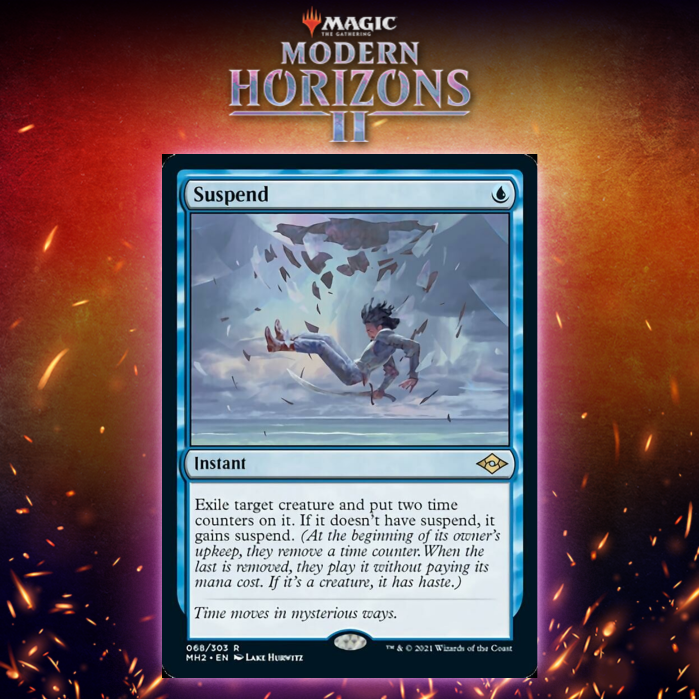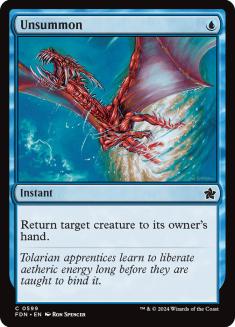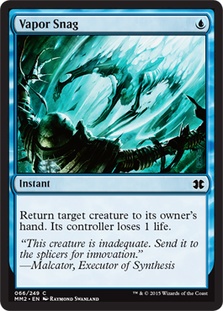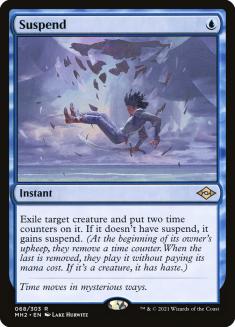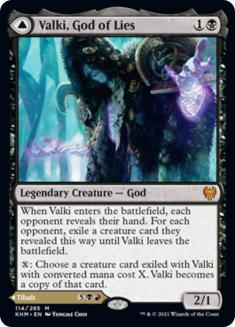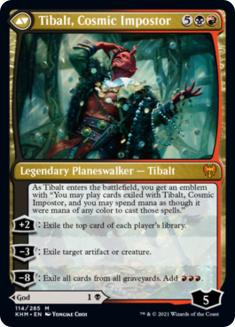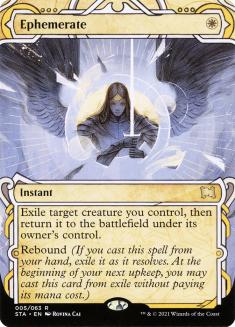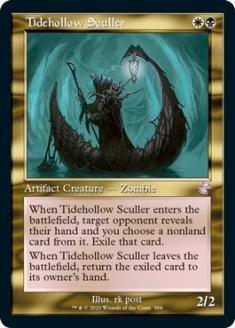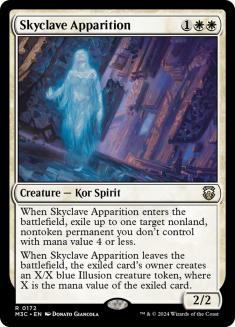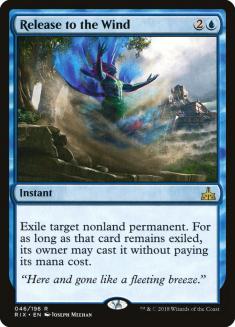Modern Horizon 2 cards are coming in hot and heavy. So many throwbacks, inside jokes, and homages to cards we know and love (or loathe), it almost feels like an Un- set, or at least Time Spiral-adjacent. Today’s article will focus on a card that has one of the more distinctive abilities in Magic, offering us a bit of time at a very cheap price.
Tempo is a word that gets thrown around in Magic a bit more than it should. I know I’m guilty of it, but the concept of tempo in any game is roughly the same. Essentially, you’re trading down on resources to stall for time. Doing so can help you close the game, making that sacrifice of a resource for that time bump meaningless in the long term. Tempo is a very short-sighted metric for determining a card’s usefulness, and often used incorrectly in a game of Magic.
Like your life total or number of raw cards in play/hand, time is a resource like any other. Some aggressive or combo decks use these types of cards as interaction points because they’re somewhat versatile, cheap, and you will usually win the game before the downside comes back to bite you. One card in Magic perfectly encapsulates tempo.
Unsummon didn’t see much play in Constructed for a long time simply because it didn’t outright deal with the problem. Against aggressive decks, bouncing a creature usually didn’t amount to much because those creatures were cheap. Against midrange strategies, Unsummon was solid, but required you to leverage that boost in mana generation to gain a full advantage. The first deck I can remember to ever play an Unsummon effectively was U/G Madness. Because the deck used cheap creatures and a color combination that didn’t have much interaction, Unsummon was a perfect fit. Bouncing a creature to buy time is exactly what the deck wanted.
The other half of Unsummon, and why it was good, is that it could protect your creatures from removal. One-for-one trading and Wrath of God were everywhere, much like today, but the core difference is that U/G Madness could cast multiple creatures at instant speed thanks to madness. Being able to bounce and recast your creature in the same breath meant Unsummon could practically invalidate specific removal from control opponents while providing the pilot a way to effectively clear the battlefield of annoying blockers.
Sometimes they print cards that do something functionally the same as another card, but give it an extra kick. Vapor Snag was unique in that blue decks rarely had ways to deal direct damage. Vapor Snag specifically worked nicely alongside a hyper-aggressive blue deck containing Delver of Secrets and Snapcaster Mage. Bouncing an opposing creature meant saving some life points and occasionally doing the last bit of damage. Delver of Secrets was so good that it could essentially hard-carry a bunch of resource-negative effects on its back. It closed games quickly enough.
The format and opposition are also great determining factors in whether or not a card like Vapor Snag is good. At the time, there were plenty of Sword of Feast and Famine decks running amok, so having a blowout like Vapor Snag at one mana to obliterate that battlefield position was clutch. So many formats feature gameplay patterns like this, which leads to some of the better blue decks ever created.
Like Unsummon, Vapor Snag could also target your own stuff to save it. That was particularly criminal with Snapcaster Mage, as attempting to kill it often meant you were somewhat far behind already. Using a card like Vapor Snag to reset one of your better spells was incredible. Sure, that one point of damage was occasionally dicey, but the ability of Vapor Snag to act as removal or protection is precisely why it was so good in the first place.
Delay was a counterspell that offered a type of interaction very similar to today’s card. Taking a spell and removing it from relevance for a few turns is a perfect encapsulation of tempo, in that you’re not actually dealing with the card outright, and are instead just delaying the inevitable. With that said, Delay was a pretty great card in the right shell, as having a temporary answer to a sweeper or big payoff was often the same as having a real answer. Like Unsummon and other bounce effects, Delay was just a way for you to bounce a spell.
The suspend ability is everywhere in Modern Horizons 2, offering us unique takes on cards that may or may not be too powerful to print with a normal casting cost. Suspend, the ability, specifically uses time as a way to measure and sculpt the game around it. A powerful card being put in suspend mode changes the landscape of the game you’re playing. Every turn the controller will be working toward building a battlefield that’s conducive to having that spell resolve. The opponent should be doing the exact opposite or formulating a plan to counteract the suspended spell.
Suspend, the card, kinda does that in reverse. Instead of starting off with a card in suspend face up for the world to see, Suspend the card allows you to control the action. You can use Suspend on a creature you control to have it blink and get another bonus from entering the battlefield. Using it on an opposing creature can invalidate some cheap threats. We all know how weak a one-drop creature can be in the later turns of a game. Finding ways to remove them from the equation early to lessen their impact later in the game is a huge part of game management.
Like Unsummon before it, using Suspend to save your own creature from the graveyard will be a major functionality. The versatility of Suspend will be its greatest strength, offering the pilot a number of ways to interact with creatures on both sides of the battlefield. There are also a few little cool combos with Suspend that make playing it much more desirable.
My old nemesis. My greatest foe. The card that singlehandedly invalidated Finale of Promise, stunting my ability to play Izzet Phoenix in Standard. Teferi, Time Raveler has been banned in so many formats that I actually had to double-check that it didn’t get banned in Modern recently. It’s also absolutely incredible with Suspend.
Teferi has this uncanny way of making cards stop working as intended. One of the most frustrating ways to use him against an opponent is with Spell Queller, as killing the Spell Queller no longer allows the opponent to cast the card that was exiled. With Suspend, it’s eerily similar, as the card hit with Suspend can’t be cast once the counters are all gone. We saw this in the original Time Spiral days with Teferi, Mage of Zhalfir, but the heavy casting cost and vulnerability to removal (i.e. being a creature) made this type of interaction less likely.
Let me be clear: you won’t always have Teferi, Time Raveler on your side of the battlefield. The static ability is extremely good, but building your entire deck around it is dangerous. You need to make sure your cards can all function well on their own. Relying on having a planeswalker on the battlefield is ill-advised. With that said, Teferi is very good, protects itself, replaces itself, and causes major headaches while trading up. Your goal is to offer up a number of other threats that are also annoying. In doing so, you’ll create a lot of tiny loops or interactions that are very difficult for the opponent to topple.
Another card that works extremely well with Suspend on your side of the battlefield:
They changed how cascade worked in Modern to prevent this type of thing from happening, but there are still a few spells that allow you to exile Valki, God of Lies and bring it back as Tibalt, Cosmic Impostor. A traditional blink effect doesn’t quite do it, but Suspend does. Removing it from the battlefield with two time counters means you get to cast it when it comes off suspend, and you can choose whatever half you want when that happens. This effect is similar to Release to the Wind, a nasty combo that started showing up in Pioneer a while back.
Valki has a lot of room to work in a shell featuring Suspend. For starters, Valki is just a pretty good Magic card. Taking your opponent’s creature can stifle their development. If that creature is Kroxa, your opponent will need immediate interaction. Everyone knows that you’re playing Valki for the back half, but there’s something wondrous about a Magic card that functions efficiently outside of its traditional role. The closest thing I can think of is Pestermite giving your opponent some serious beatdowns, even though it was specifically put in the deck to pair with Splinter Twin.
Grief is another card printed recently that works well with any blink effect. While everyone was talking about Ephemerate at first, I think Suspend could be another tool to ensure Grief keeps doing its job. In fact, I don’t see why we couldn’t build a dedicated blink deck featuring all sorts of creatures that don’t mind getting phased out of existence at instant speed.
Specifically for this shell, Grief is a great way to tag your opponent’s hand and keep them light on interaction or threats, depending on the situation. While it’s technically negative on card economy, we’re often trading away that card economy to gain footholds on the battlefield or using them like creating more virtual mana. In a deck featuring both Ephemerate and Suspend, Grief could be incredible. The trick here will be deciding the rest of the shell that goes around it.
I have two main avenues I’d like to explore.
Creatures (19)
Planeswalkers (4)
Lands (22)
Spells (15)

This deck is a little light on creatures for so many blink effects, but the raw power of these cheap blinks with Grief cannot be accurately described. They have to be seen or felt; the noises your opponents make have to be heard to be believed. It’s over, they’re dead, that’s game. Ephemerate is obviously the better of the two in a traditional sense, giving you multiple effects when you cast it and doing the job intended. However, the X-factor of Suspend with Valki is important for winning longer games where attrition matters. Suspend can also double as a way to buy some time while you get set up, as your interlocking pieces are all a bit clunky and expensive outside of the all-star that is Grief.
This deck tries to use all the elements we discussed in the first portion of the article. It’s possible we’re trying to do too much at once, but we won’t know how much of any effect is “too much” until we push the envelope. With two cards acting as complete blowouts with Grief, it’s important to understand that getting stranded with one or two of those effects for a turn or two is fine because they allow for some huge turns that will leave the opponent scratching their head.
One thing I’m worried about is that we aren’t playing enough creatures, but we can fix that by adding more copies of Reflector Mage or Skyclave Apparition. I want an even amount of hand disruption and creature interaction so we’re equally capable of interacting with the many different archetypes that Modern throws at us. Being too reliant on one method of interaction or the other could leave us cold to strategies trying to dodge that form of interaction.
Next up, a version inspired by a Pioneer deck!
Creatures (9)
Lands (22)
Spells (29)

Release to the Wind picked up some steam in Pioneer with the printing of Valki. Finding ways to cheat Tibalt onto the battlefield is a big game. Suspend is very similar to Release to the Wind, with the key difference that we’re trading explosiveness for efficiency. Release to the Wind and Valki together allow for instant transformation, but the mana investment is harder to justify in a format like Modern. Suspend costing one mana means you get to sculpt the turns leading up to casting the planeswalker, and you’ll also be able to hold up mana on the turn you cast it.
Ancestral Vision taught me a valuable lesson: having your spells resolve without costing you mana means you get to use all your mana to defend yourself, defend your spells, and clear space on the battlefield for your more important cards. Suspend does this in a unique way with Valki, setting up a ticking time bomb for a small mana investment. On the turn where you cast Tibalt, you get to have all your mana untapped. I can’t think of a more desirable scenario.
One major draw of this version is Lurrus of the Dream-Den. The freebie slot of Mishra’s Bauble makes Lurrus a little less intense on the mana side, as it lets you gain value immediately. In the long game, you have Unearth to bring it back, giving you ways to create unbreakable chains where any sort of interaction from the opponent will get overwhelmed. It will also allow for more Valki on the battlefield, giving life to Suspend when copies start to get clogged in your hand.
Last but not least comes a version built around one of Modern’s strongest mana engines.
Creatures (23)
- 4 Tidehollow Sculler
- 3 Sin Collector
- 4 Thraben Inspector
- 4 Valki, God of Lies
- 4 Callous Bloodmage
- 4 Grief
Planeswalkers (4)
Lands (21)
Spells (12)

Using Aether Vial, we’re generating absurd amounts of mana to put multiple three-drops onto the battlefield at the same time. Our eight blink effects work nicely with Grief again, giving us blowout potential while maintaining the threat of Valki with Suspend.
There’s a tough balancing act in finding the right number of black cards to make sure you can evoke Grief on the first turn, but playing weak cards just to add more black cards to the deck is not something I really want to do. We’re already deep on Callous Bloodmage, a fine card but not one that sees regular play, to up our count while keeping Aether Vial and our blink effects in business. Ideally we’ll be able to find another black card or two that fits into this archetype, but that will take some hours scouring Gatherer.
Suspend is tough to decipher at first glance because its effect is cheap, unique, and potentially game-breaking with the right pairing. We’re putting all of our eggs into the Valki basket while trying to find other cards that make it viable as a way to target our own stuff. My best guess is trying to use it like an extra blink for powerful enters-the-battlefield effects, but an emphasis on using it on your opponent’s stuff is also something to explore.
Suspend is such a weird card because most tempo-driven cards are worse against cheap threats from the opponent. Suspend is actually the opposite, shining as a way to divert early damage from threats that diminish in value over time. For one mana, you have a card that can buy you time, combo with Valki, or be a weak way to trigger your enters-the-battlefield effects. Alongside Grief specifically, Suspend is disgusting, as the only thing you’re searching for is a way to cheat it onto the battlefield after casting it for free. Ephemerate is obviously a bit better, but that’s why we’re jamming both in the decks that actually play Grief.
I’m always excited to get my hands on some new cards. As a deckbuilder, all I want is to find interesting or unique interactions. As a grinder, all I want is to figure out the best builds with powerful cards. When I get my hands on a tool like Suspend, my creative juices go into overdrive. It has some obvious uses, some obscure uses, and naturally surrounds itself with some of the most powerful cards in Modern. Who wouldn’t want to do cool blink shenanigans?
However you end up building around Suspend, expect to be surprised at how good it is. I have a feeling it’ll be much better than it looks on paper, specifically because of how good hitting your opponent’s creatures will end up being. It’s like the opposite of Vapor Snag. It’s like the hidden value in Path to Exile of targeting your own creature.
We’re only scratching the surface on how to use Suspend. There are so many powerful creatures in Magic with on-cast or enters-the-battlefield effects, there just has to be some absurd interaction we have to dig deep to find. It’s just a matter of time.

